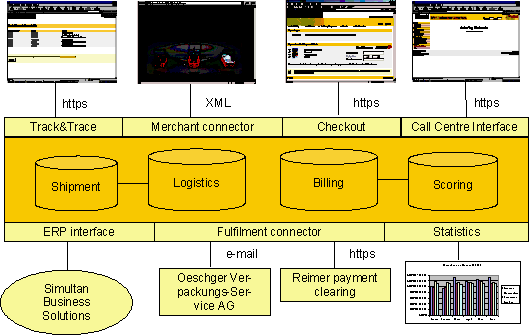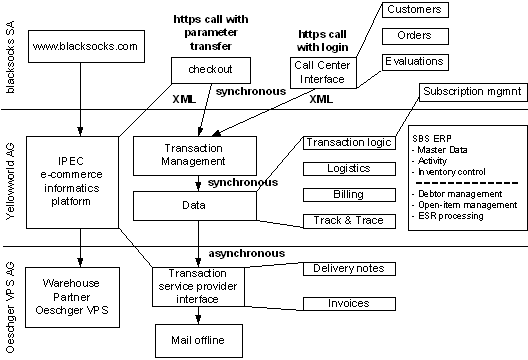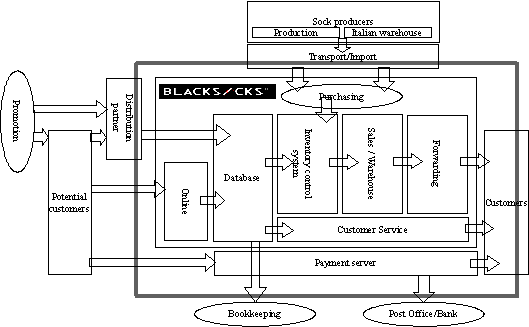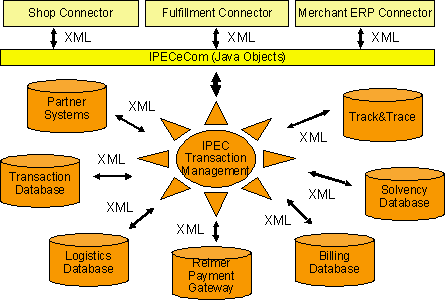blacksocks SA e-fulfilment solution
blacksocks SA is a subscription-based service provider in the men’s clothing industry that is strongly focused on developing customer retention. blacksocks SA can be also be considered as a single-product company. Its positioning means its range is restricted to men’s black socks. With few exceptions, the entire fulfilment between purchasing and selling is provided by yellowworld AG. The fulfilment solution is pragmatic and orientated to scalability.
Table of Contents
1. The company2. e-Business vision and e-business strategy
e-Business concept, business model, transaction phases, yellowworld
3. Fulfilment solution
Order process, interfaces, Call Center, Data import, Inventory management, payment solution
4. Implementation
System architecture, IPEC, Three-level model, IPEC architecture
5. Operation
Turnover
6. Success factors
1. The company
The company blacksocks offers socks on subscription. With a few exceptions, the company only appears in the internet. Because of its simple business and fulfilment model, it is ideally suited as a case study.
Background
blacksocks was founded in June 1999 as a collective and has existed in its present form, with the corresponding fulfilment partners, since October 2000. As a collective, the company had a considerably simpler business model. It all began with a simple website. The site had no database connection at the time and processing was performed largely by hand. The company became a listed company in autumn 2000. Fulfilment processes were outsourced to yellowworld, enabling them to be extensively automated and integrated. Media disparities were eliminated in the process.
The original business idea to offer socks on subscription was hatched back in October 1994. The decision to put the idea into practice was reached in November 1998. From December 1998 a business plan was created and, by March 1999, the first sock suppliers were being evaluated. The company found suitable suppliers offering very high quality standard in northern Italy (in the Siena area). The brand name “blacksocks” was also first coined in March 1999. The company went online in July 1999. The new website – as it appears today – was launched in November 2000. In January 2001, together with a franchisee at www.blacksocksUSA.com, the company entered the U.S. market.
As of July 2001, the Swiss company employed a total of 2.4 employees. There are also six posts at blacksocks’ outsourcing partners, of which 3.5 work in the fulfilment area. The founders and majority shareholders are Marcel Roth and Samy Liechti. Marcel Roth is responsible for procurement, sales, finances and customer service. The managing director, Samy Liechti, is responsible for strategy, operations, marketing and communications.
Industry
blacksocks is active in the men’s clothing industry. The position occupied by the service on offer – selling socks on subscription – is fairly unique within the industry. Thus the company sees itself primarily as a service and not as a trading enterprise.
The competition: Various companies have tried, and are still trying, to copy the blacksocks concept. www.socksinabox.de *, www.danieli.ch, www.dr-socke.de*, www.soccus.de, www.bonsche.de/socke.htm* and www.topsocks.ch* [*= offer not available]
Product
The company does not offer a product in the actual sense of the word. It sees its service as a combination between a service and a product. Sock subscriptions are available for black, hooped and ribbed full-length and calf socks. A sock subscription costs from CHF 98. The customer assembles his sock subscription from various parameters himself. They are as follows: Delivery cycle (3, 4 or 6 deliveries, each of 3 pairs of socks), sock type (knee-length or mid-calf socks), sock size (37 to 48) and subscription type (sock subscription or sock gift subscription).
Each delivery is more than just an envelope containing three pairs of socks. Rather, the deliveries are used to inform the customer in an entertaining way about the socks’ main points. This relationship management to the sock subscriber most of all serves to retain customers. The customer service is also orientated to customer satisfaction and loyalty, in that it is not based on impersonal business relations, but strives to handle customers’ day -to-day problems in an accommodating way.
As already mentioned, the quality of service and the quality of the socks it supplies are of prime importance to blacksocks. The socks themselves are produced from high-grade Peruvian Pima wool (making up 85% of content). Small quantities of synthetic fibres are also present in the fabric to prevent slippage. Production is on circular knitting machines, a method that raises wearing comfort. The socks satisfy the Ökotex 100 Standard as far as materials and production are concerned; in other words, they are dermatologically safe. The yarns undergo extensive testing for wear resistance and colour fastness.
Target group
Various target groups in the B2C and B2B areas can be distinguished.
In the B2C area, blacksocks sells subscriptions mainly on the Swiss market, but also serves customers in 20 EU member states and elsewhere. The core target group in the B2C area can be characterised as follows: male, office worker in a high position, more at home in a cultivated environment and aged between 30 and 50.
In the B2B area, we can distinguish between sales agents and distribution partners who sell on to end customers (e.g. youSmile.de) and companies and customers who use sock subscriptions as a customer-retention instrument for their own customers. This customer group makes it possible to add individualised delivery notes and customised delivery rhythms.
In future, not only the Swiss market will be expanded but also sales to the British, German and Austrian markets.
2. e-Business vision and e-business strategy
blacksocks’ vision is that:
blacksocks will free the world from sock sorrows by means of socks on subscription.
Based on this vision, the following principles have also been laid down. The company does nothing itself that others can do better. It lets its partners participate in its successes – not through shares, but with cash. blacksocks seeks the lowest possible fixed costs. In order to guarantee delivery availability, the company needed a scalable business model. The company sees its pioneering abilities as lying more in its expansion under the innovative business model and less in managing what it has already achieved. blacksocks has set itself the goal of entertaining its customers.
Strategy
Aided by the subscription service, a broad customer base was targeted for development. It was planned to retain customers over a longer time period and to use them as multipliers, i.e. to enlist more customers. Customers are viewed as an asset for targeted investment. Through quality of service and quality of the delivered socks, the customers’ expectations must be surpassed and so lead them to stay loyal to the company longer. This strategy targets sustainable and profitable growth.
The provider's e-business concept
blacksocks’ e-business concept comprises the subscription marketing of black knee and mid-calf socks via the internet and the fulfilment of subscriptions using the e-commerce informatics platform (IPEC) at yellowworld. The latter coordinates warehousing and other participating fulfilment partners.
The following services are outsourced to yellowworld (cf. Fig. 1): Logistics and warehousing, billing, enterprise resource planning (sales, warehouse, dispatch, payment etc.), operation of the checkout platform and the necessary database links.
Scope of services
The case description, taking into account the e-business systematic [transaction phases] consisting of orientation, information, agreement, fulfilment and loyalty phases, is as follows:
The orientation phase is characterised by three different entrances to the website – one access point for nostalgics (signified by an empty shopping basket), an entrance for the playful (signified by a shopping basket with an airplane) and a gateway for people in a hurry or purists (recognisable by a shopping basket full of lemon presses [for French pressé = in a hurry]).
The gateway for nostalgics is via a screen showing a black knitted sock pattern across its entire width. By slowly scrolling down, the viewer learns more about blacksocks and its service. The entrance for the playful shows a cartoon chest of drawers whose various drawers serve navigation. For example, the chest of drawers shows content connected with purchasing and information for customers, or a telephone that enables e-mail communication with blacksocks’ customer service. The entrance for purists shows the simple order form.
All information on the blacksocks website can be assigned to the information phase. Subscription-specific information can be found and selected on a page listing subscription types, prices, sock types etc. After defining and confirming the relevant subscription parameters on the website, the customer is taken to the checkout on the IPEC platform. The customer, together with the data collected from the website, is then transported to the agreement phase.
The loyalty phase begins with the first delivery of socks on subscription. As described, this is where dialogue with the customer is sought. A credit query can also be counted part of the loyalty phase.
Partners
Contact to yellowworld as general contractor for fulfilment was made through a press article. Three offers were brought in. The one submitted by yellowworld best matched blacksocks’ requirements.
yellowworld, the post office’s e-business arm, links logistics and financial processes with the latest internet technology. It operates these solutions securely. The module product architecture enables solutions tailored to the customer that can be quickly implemented and upgraded at any time. blacksocks was one of the first fulfilment customers on the IPEC platform. As general contractor, yellowworld proposed two warehousing partners. Because of its size and level of quality, the company of Oeschger Verpackungs-Service AG, Wettingen, was selected.
Headbanger, the partner in Neuenburg, was responsible for designing and maintaining the website. This relationship was coordinated directly by blacksocks. Contact to Headbanger came about through Mr. Liechti. In the past, he worked together with the company’s founder and owner. The order for the website was ready in time for Christmas 1998.
Web hosting was undertaken by the company SysCo Systèmes de Communication SA in Neuenburg.
An Italian sock producer was acquired in the Siena area that, depending on requirements and stocks, was able to supply the corresponding warehouse partner, Oeschger Verpackungs-Service AG in Wettingen.
3. Fulfilment solution
This subchapter describes the functions, processes and interfaces required for the case from blacksocks’ viewpoint (cf. Fig. 3.1).
Order process: The data relating to the selected type of subscription are generated using the navigation on the website. The data thus collected is then passed to the checkout at yellowworld. At the checkout, the customer receives information about the availability of the desired socks. In addition, the service description and terms (prices) relating to the order are once again listed in summary.

Fig. 3.1: Interfaces to the IPEC architecture relating to blacksocks.
In a further navigation stage, details relating to delivery and billing address appear. In the third stage customers are presented with possible payment types. Once the desired payment type has been selected the customer is once again shown a summary. To effect the purchase, the data from the checkout are passed to the IPEC transaction management system.
The electronic payment option is first subject to validation before the order is definitively closed. At the checkout, the customer receives a confirmation with the corresponding customer and order numbers supplied by IPEC. If an e-mail address is available, IPEC sends confirmation of the order via e-mail to the billing address. The customer has the option of dispensing with the confirmation mail, or can have it sent as an e-mail to the delivery address. The system generates the corresponding order in the ERP system. If the “physical invoice” payment option is selected, a corresponding invoice slip is prepared in the ERP system. The order data thus generated is now available for further processing and are displayed to the customer via the Track&Trace interface and, if desired, on the blacksocks website as well.
Customer changes: The customer registers his wishes for changes to blacksocks’ Customer Service, which makes address changes on an ongoing basis via the Call Centre Interface. Important changes, such as those concerning the subscription, are sent every week by blacksocks to yellowworld via e-mail (Excel file). In addition, blacksocks passes the bonus-socks credit to yellowworld once a week in the same way as the customer changes.
Call Centre Interface: If, instead of ordering via the website, a customer contacts blacksocks customer service directly, the member of staff is provided with a further synchronous input screen in the shape of the Call Centre Interface. The relevant data are recorded on the screen provided and are likewise sent to IPEC once complete. “Physical invoice” is currently available as a payment option. Further processing is similar to the online customer order.
Import of external data [data import] (e.g. for mass orders from the B2B sector): If required, an asynchronous interface is available for migrating data from an external database. For this purpose, the data are supplied directly by blacksocks in a predefined XML structure or converted into the corresponding form by a “converter” at yellowworld after data transfer. From the point in time of complete data migration to IPEC, further order processing resembles that for online input. This interface should only be used in exceptional circumstances.
Master data management: As illustrated in Fig. 3.1, transaction-specific master data management for customers, billing and logistics is handled using the ERP software from Simultan Business Solutions.
Complaints, reclamations and goods returned are made by the customer directly to blacksocks’ Customer Service. If necessary, Customer Service uses the Call Centre Interface and coordinates further steps. yellowworld may also be contacted.
Flow of information and Track&Trace: When ordering online the customer is immediately shown information on the availability of the desired product and details such as customer and order numbers. These two “key numbers” are noted in the corresponding e-mail confirmation and on the delivery note. This enables the customer to call up information on order status, remaining credit balance and upcoming delivery details at any time via the blacksocks website. This information is presented on the delivery note for offline orders.
Inventory management Via the Call Centre, blacksocks has a permanent overview of available and ordered sock quantities and can inform the suppliers of short-notice demand. Thanks to the offline interface at the firm of Oeschger, these stock figures are balanced quarterly against those on the IPEC platform. yellowworld informs of any substantial difference by e-mail. blacksocks reorders from the producer’s production department or warehouse. Once delivery is made, Oeschger reports the incoming goods to yellowworld via e-mail where the incoming goods booking is input manually.
Data transfer to Oeschger VPS: After processing in IPEC, the order data are transferred to Oeschger Verpackungs-Services via an interface to an asynchronous service provider. Oeschger prints delivery notes and invoices, picks the order and hands it over to the Swiss postal service for dispatch. It is planned to connect Oeschger Verpackungs-Service AG to the ERP software integrated in the IPEC platform via a software link, probably by the end of 2001.
Financial flow on payment [payment solution] by credit card or Swiss postal account: The customer chooses the preferred method of electronic payment at the checkout. For customers outside Switzerland, this covers VISA, Mastercard and American Express; Diners can be connected at any time. Once the transaction has been successfully completed, the purchase order is reserved by the payment provider. After five working days, the applicable credits and deductions are made.
Payment by physical invoice: This method of payment is only available for customers with a billing address in Switzerland and can only be made in Swiss francs. The invoicing data generated in IPEC are presented in a predefined invoice form which is dispatched together with the consignment. yellowworld then generates an open item position for the invoice, before checking the open item list at the reminder intervals specified by blacksocks and, if required, creating a letter requesting payment with a remittance slip. The payments resulting from the reminder process and invoices are booked in IPEC and credited to blacksocks’ account. A list of open items is mailed to blacksocks once a week. When a customer has received two reminders for payment, blacksocks decides on the further course of action and informs yellowworld of its decisions at weekly intervals. Since further deliveries will not take place until two or three months afterwards, it is possible to cancel further deliveries for customers in arrears.
4. Implementation
Technical platform [system architecture]
The technical platform used for fulfilment processing is IPEC, the e-commerce informatics platform at yellowworld. Using IPEC it is possible to develop customised e-fulfilment solutions for any company that prefers not to or is unable to provide this functionality itself. yellowworld is the only company in Switzerland to undertake for its customers operation of e-business processes in the finances and logistics sectors as an outsourcing partner.
The IPEC transaction platforms is based on Microsoft’s Windows NT. Among others, it includes the Simultan Business Solutions software Enterprise Resource Planning (ERP) that manages transactions for customers, deliveries, debtors etc.
Batch output files are generated three times a day for preproduction chits, delivery notes and invoices that are then sent to Oeschger Verpackungs-Service by e-mail produced with Cristal Report software. Based on these e-mails, Oeschger can print invoices and delivery notes.
The blacksocks website is HTML-based. Its animated effects were created using the Macromedia Flash Player Version 5. The customer uses the website to specify subscription details. To enable the customer to define methods of payment, he is transferred via a secure SSL connection to the checkout interface on the IPEC platform. Once the payment method has been defined, the customer is rerouted to the blacksocks website via the SysCo servers in Neuenburg.
IPEC architecture
A detailed description of the IPEC platform’s blacksocks-specific architecture is beyond the scope of this business case as it is too complex to explain briefly. The following illustration gives a schematic overview.

Fig. 4.1: blacksocks architecture
IPEC’s transaction management is connected to the blacksocks website and the fulfilment and the ERP connectors via IPECeCom Java objects and the XML standard. The IPEC transaction management’s links to partner systems such as transaction, logistics, billing and credit-check databases and the payment gateway are based on the Microsoft XML format.
The IPEC system architecture is based on a three-level model. Specific solutions for processing goods and cash flows are deployed as central data-keeping systems. The first level represents the data origin (access). The data origin may be an internal system or external access. The IPEC transaction server (application) is the second layer. It verifies the data, prepares them and performs the necessary transactions. The transaction server is the interface between the first level of data origin and the third of data-keeping. The third level is covered by data-keeping (database) with activity and master data. Exclusive use is made of relational databases.
Firewalls ensure protection against unauthorised access to data and transactions between the stages. In this model, the data origin, the transactions and the data-keeping are kept clearly separated. The individual levels communicate with each other via XML/http in which the protocol guarantees complete data transmission.
Thanks to its open interfaces, this architecture enables flexible implementation of new requirements without endangering the overall system’s stability and security. The strict separation of data and application levels guarantees data consistency at all times. The close cooperation between yellowworld and the software partners ensures on-site expertise and extremely short reaction times.
5. Operation
Maintenance
With the exception of the website design update, yellowworld has sole responsibility for maintaining the fulfilment solution. Changes to the front-end at www.blacksocks.com are the sole responsibility of the firm of Headbanger.
Profitability
No details on the solution’s profitability could be obtained nor were any specific running costs for operation provided.
Turnover / Return
The company has published the following figures. At the end of 2001, it had budgeted to sell 10,000 subscriptions. By mid-July 2001, the figure of 5,500 had been achieved. Based on sales of CHF 1 million, the company budgeted to sell 100,000 pairs of socks by the end of the year.
6. Success factors
The solution’s specialities
The firm of blacksocks and its solution exemplifies in no small measure the radical concentration on management and the qualitatively high-ranking customer and supplier relationships. An added success factor is its concentration on lean and simple processes in providing fulfilment. Another aspect that should not be ignored is the quality of service provided by its sock subscriptions with regard to timeliness and quality thanks to the option of sending the socks by ordinary mail.
Unique selling proposition
Thanks to the blacksocks sock subscription, bothersome sock purchases are a thing of the past because the subscriber has his sock needs covered adequately and regularly. Furthermore, the customer always receives the same socks so that s/he does not have to make time-consuming selections every time s/he makes a purchase. Finally, the business idea behind the sock subscription is conveyed in an entertaining way.
Lessons learned
Cooperation with the fulfilment partners presented no problems. The project was initially underestimated for its complexity despite – or perhaps because of – its apparent fundamental simplicity.
blacksocks consistent use of an ASP approach for areas that were not part of the company’s core competencies can be judged valuable, especially in view of the following points:
- The fulfilment partner is responsible for the solution’s functioning
- blacksocks profits directly from technical innovations
- Thanks to a modular and fully-scalable architecture, requests for changes and/or expansions can be quickly realised.
- The solution achieved a high degree of variableness in costs, which in effect amounts to investment protection.
- Secure data handling was accorded particularly great importance in selecting the fulfilment partner.
yellowworld is based on the Swiss post office’s services and is thus the only company in the Swiss e-business market to be able to offer secure one-stop logistics and financial processes.





